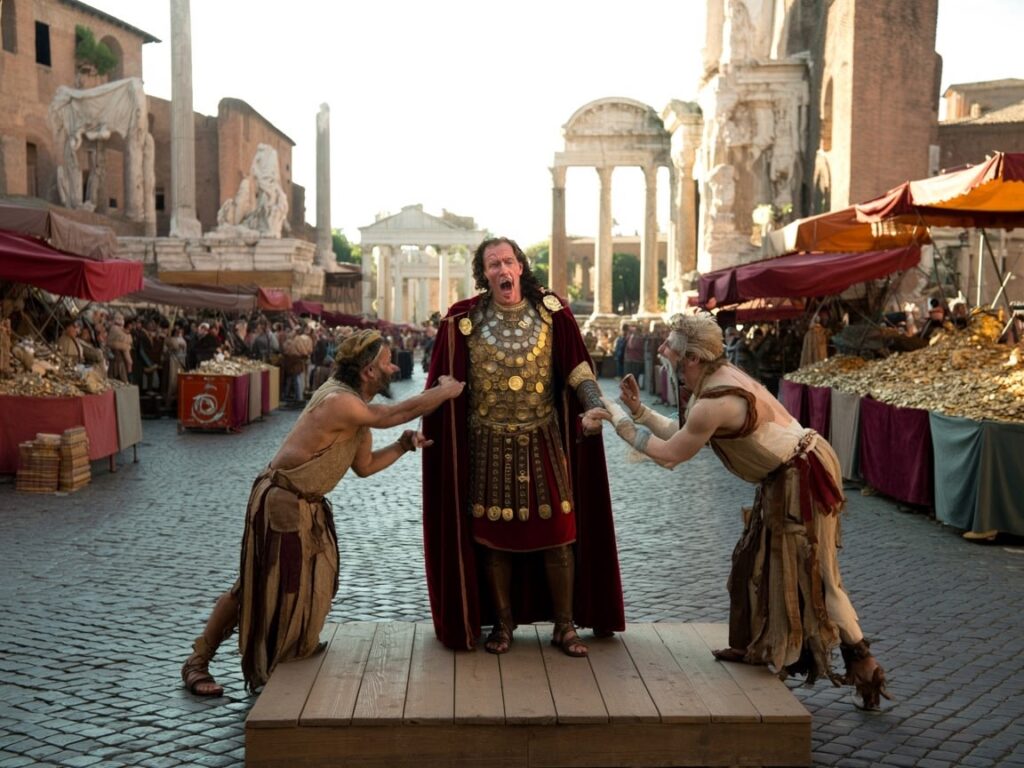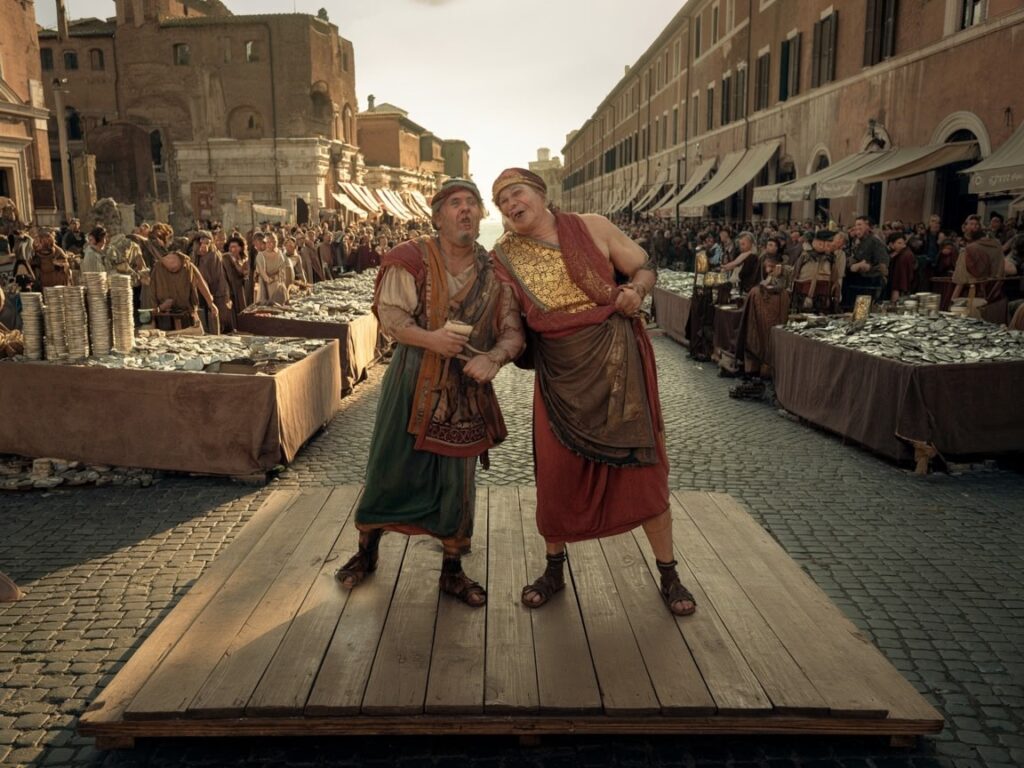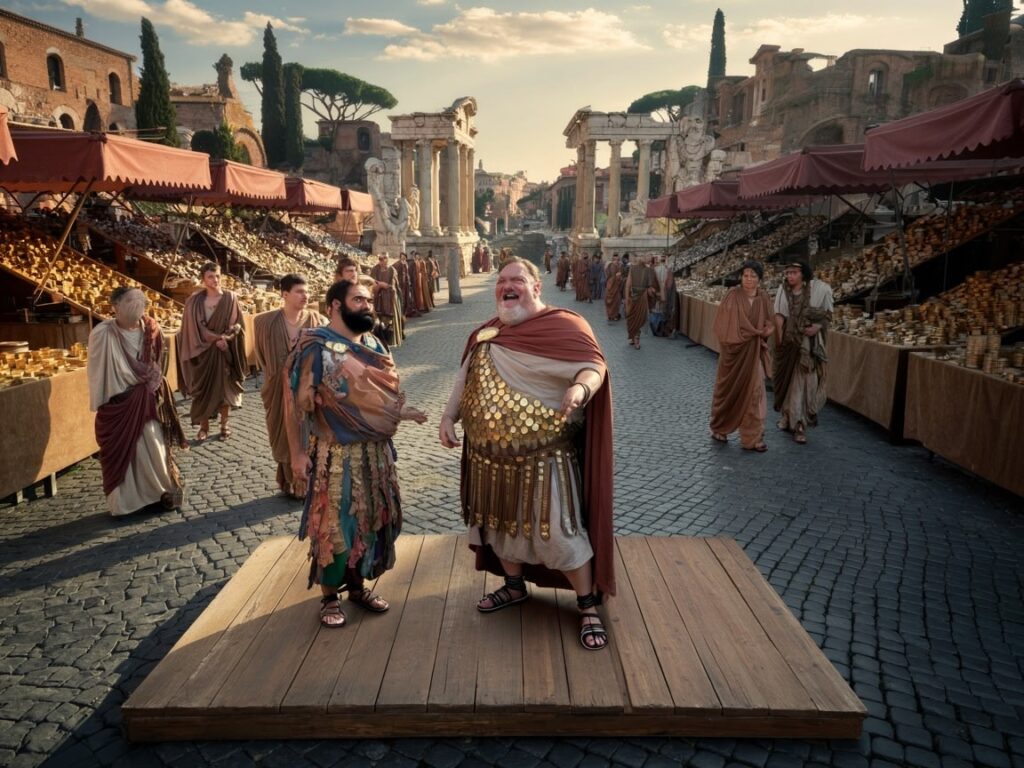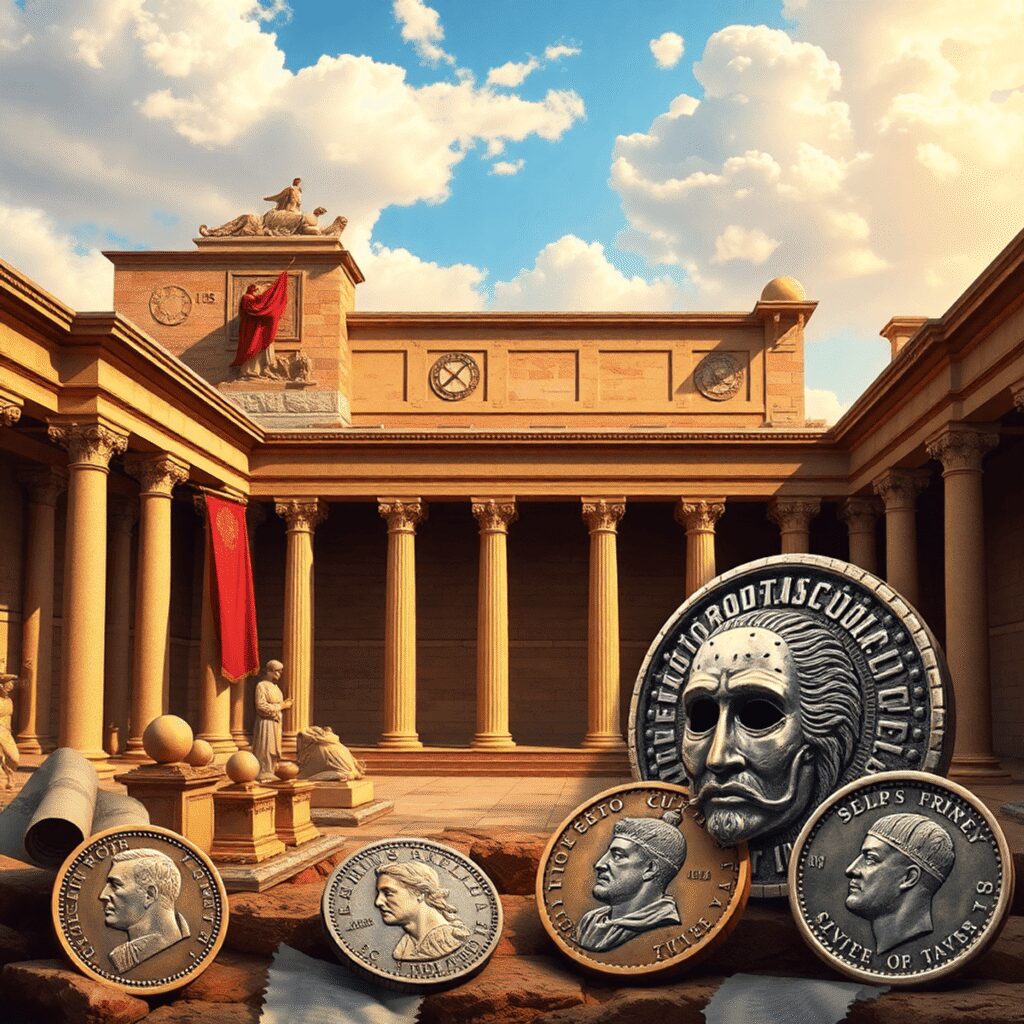Roman satire is a powerful literary genre that combines comedy with social criticism. It is deeply rooted in the culture of ancient Rome and uses humor not just to entertain but also to challenge those in power. Roman comedians used satire as a sharp tool to expose the flaws, corruption, and hypocrisy of political leaders and public officials.
Key aspects of Roman satire:
- Combines wit, irony, and exaggeration to provoke thought.
- Targets societal vices and abuses through laughter.
- Acts as a mirror reflecting moral decay and incompetence.
This form of satire did more than mock; it aimed to provoke societal change. By laughing at the powerful, Roman comedians created space for critical dialogue and reflection. Their work continues to influence how humor challenges authority today.
However, it’s important to understand that the power dynamics in ancient Rome were influenced by more than just comedic critique. Other factors also played significant roles. For example, coins were used as powerful tools by emperors to convey their authority and legitimacy. These small pieces of currency had a purpose beyond being just money; they became important instruments for political messaging.
Furthermore, the trade and economy in Ancient Rome were crucial to its vast empire, impacting both everyday life and long-term stability. Understanding these complex systems sheds light on the importance of economic practices that shaped one of history’s most powerful civilizations.
Understanding Roman Satire
Roman satire is a unique Roman literary genre that uses humor, irony, and exaggeration to expose social flaws and criticize those in power. The word satura originally referred to a mixture of poetic forms but later came to represent this specific style of social commentary. Early Roman writers used satura as a way to indirectly address societal issues, making it a flexible tool in both literature and public discussion.
Key Elements of Roman Satire
The power and appeal of Roman satire are defined by three key elements:
- Humor: Not just for entertainment, humor in satire serves as a sharp instrument to reveal human mistakes and societal problems. It softens criticism while making it more impactful.
- Irony: Irony often undermines what seems obvious, highlighting contradictions between appearance and reality. This exposes hypocrisy or injustice without directly confronting it.
- Exaggeration: Satirists amplify vices or absurdities to ridiculous extremes, forcing audiences to recognize the seriousness or absurdity of the issues being criticized.
The Purpose of Roman Satire
Roman satire is not just comedy; it is serious commentary disguised in wit. It reflects both individual weaknesses and systemic corruption by holding a mirror up to society. The combination of these elements allows satire to effectively challenge authority while entertaining readers and listeners with cleverness instead of direct attacks.
The term satura itself emphasizes this blend—originally meaning a ‘full dish’ mixed with various ingredients—apt for a genre that combines different styles and tones to provoke thought through laughter. This shift from poetic form to social critique established Roman satire as an enduring tradition in Western literature.
Influence of Roman Culture on Satire
The broader context of Roman culture, including its art and sculpture, greatly influences the themes explored in satire. Masterpieces of Roman Art, which emerged from the blending of various cultures, serve as evidence of the empire’s wide influence and its ability to absorb and innovate. Similarly, the evolution of Roman sculpture, with its emphasis on realism and depiction of power, reflects not only artistic expressions but also functions as tools for political propaganda and religious devotion. These artistic traditions provide a rich backdrop against which the satire unfolds, offering deeper insights into the societal dynamics being criticized.

Types of Roman Satire: Horatian vs Juvenalian
Roman satire developed into two distinct styles named after its most famous practitioners, Horace and Juvenal. These styles represent different approaches to social critique through humor.
Horatian Satire
Horatian satire is characterized by its gentle and lighthearted tone. It aims to amuse and gently correct human follies without resorting to harsh judgment or ridicule.
Key Features of Horatian Satire
- Tone: Gentle, lighthearted, and playful.
- Purpose: To amuse and gently correct human follies.
- Style: Uses wit and mild irony without harsh judgment.
- Target: Human weaknesses and everyday absurdities rather than direct attacks on individuals.
- Example: Horace’s satires often poke fun at societal habits with a sympathetic attitude, inviting readers to reflect without feeling attacked.
Juvenalian Satire
Juvenalian satire, on the other hand, takes a more aggressive approach. It employs savage ridicule and biting sarcasm to provoke outrage and expose serious moral corruption.
Key Features of Juvenalian Satire
- Tone: Harsh, bitter, and scornful.
- Purpose: To provoke outrage and expose serious moral corruption.
- Style: Employs savage ridicule, biting sarcasm, and outrage.
- Target: Those in power—political leaders, corrupt officials, and societal vices.
- Example: Juvenal’s works are known for their fierce condemnation of greed, hypocrisy, and decadence in Roman elite circles.
Comparing Horatian and Juvenalian Satire
| Aspect | Horatian Satire | Juvenalian Satire |
|---|---|---|
| Humor | Playful and gentle | Bitter and aggressive |
| Criticism Style | Sympathetic, corrective | Scornful, condemning |
| Targets | General human folly | Corruption among the powerful |
| Emotional Impact | Amusing reflection | Provokes indignation |
You may find that Horatian satire offers a softer lens on societal flaws, encouraging self-awareness through humor. In contrast, Juvenalian satire confronts issues head-on with sharp invective designed to shock and mobilize readers against injustice. Both styles shaped Roman satire’s ability to challenge authority using laughter as a weapon.

Prominent Roman Satirists Who Challenged Power
Roman satire found its most influential voices in Horace and Juvenal, two satirists whose works remain defining examples of the genre. Both used satire as a sharp instrument to critique political leaders and public officials, but their methods and tones varied significantly.
Horace: The Gentle Critic
Horace (65–8 BCE) is often credited with shaping the form of Horatian satire, blending humor with a kindly, almost affectionate tone. His critiques were pointed yet tempered, aimed at encouraging moral reflection rather than outright condemnation.
- Targeted issues included:
- The vanity and pretensions of the Roman elite
- The follies of social climbing
- Flaws in public behavior among politicians and aristocrats
Horace’s wit was subtle, using irony to highlight hypocrisy without causing direct offense. His work reflects a desire to improve society by gently exposing human weaknesses through laughter.
Juvenal: The Fierce Exposer
Juvenal (late 1st century – early 2nd century AD) represents the harsher voice in Roman satire, known for Juvenalian satire. His writings unmasked corruption and moral decay with relentless scorn and savage ridicule.
- Major themes included:
- Political corruption and abuse of power
- Social injustice and inequality
- Hypocrisy among religious and civic leaders
- Moral decadence affecting Roman society at large
His tone was aggressive, often invoking outrage to shock readers into awareness. Juvenal’s work did not merely entertain; it aimed to provoke discomfort about societal failures.
Shared Focus on Exposing Vices
Both Horace and Juvenal excelled in using humor as a weapon against the powerful. Their satire:
- Revealed hypocrisy among rulers who preached virtues they did not practice
- Highlighted moral decay eroding Rome’s political institutions
- Used wit to hold public figures accountable without direct confrontation that could risk censorship or reprisal
Their legacy as pioneers of Roman satire underlines how comedians wielded laughter not just for amusement but as a tool to challenge authority and inspire change. Their works continue to serve as classic examples of how humor can intersect with serious political criticism.
The themes explored by these satirists resonate deeply with the historical context of their time, a period marked by political instability and weak leadership, which ultimately contributed to the crumbling foundation of Rome. Such internal strife was further compounded by an ineffective governance system, leading to societal decay that both Horace and Juvenal sought to expose through their poignant satirical works.
In addition to the political aspects, their works also reflect upon the broader societal values influenced by the Roman Pantheon, which consisted of gods representing various facets such as power, justice, and wisdom.

How Roman Satire Criticized Authority
Roman satire used wit and humor as clever weapons against authority. In a society where speaking out could lead to harsh punishment, directly confronting rulers or officials was dangerous. Instead, satirists became skilled at indirectly challenging those in power through their writings, making fun of them without openly defying them. This strategy allowed criticism to bypass societal defenses by disguising it as entertainment.
Key Techniques Used by Satirists
Satirists employed various techniques to convey their messages:
- Irony and double entendre: They often used language with multiple meanings — one funny, the other sharply critical. This ambiguity allowed audiences to understand the underlying critique while giving the author plausible deniability.
- Exaggeration and caricature: By exaggerating flaws and vices, satirists exposed corruption and moral decay in a humorous yet revealing way.
- Parody of official rhetoric: Mimicking speeches or policies enabled satirists to mock authority figures by highlighting their hypocrisy or incompetence.
The Role of Satire in Society
Satire served as a release valve for social tensions, providing an outlet for public frustration. People could laugh at the mistakes of their leaders, expressing dissatisfaction in an acceptable manner. This released pressure within society without causing direct rebellion or censorship.
The combination of laughter and critique made satire an effective tool for criticizing authority. It created a space where societal norms and abuses were questioned through humor rather than violence. This method protected the satirist’s voice while encouraging reflection among both rulers and citizens.
Interestingly, this critique wasn’t limited to political figures but also targeted various aspects of Roman life, including their deeply ingrained religious practices. These practices, involving numerous rituals and sacrifices, were often ridiculed in satirical works as they were believed to maintain good relationships with their many gods, influenced by earlier cultures like the Greeks and Etruscans.
The lasting impact of Roman satire lies in its ability to balance amusement with subversion — using laughter as a tool to expose power’s flaws while also reflecting on societal practices.

Impact of Roman Satire on Society and Literature
Roman satire played a crucial role in encouraging societal change by holding those in power accountable through laughter. By exposing the flaws and vices of political leaders, public officials, and societal norms, satire prompted audiences to reflect on ethical standards and governance. This reflection often sparked discussions about morality, justice, and reform, making satire a subtle yet effective catalyst for improvement within Roman society.
Key impacts on society include:
- Accountability through humor: Satire allowed criticism without direct confrontation, making it safer to challenge authority figures.
- Public awareness: By highlighting hypocrisy and corruption, it educated the populace on social issues that might otherwise remain unspoken.
- Cultural introspection: Encouraged individuals to examine their own behaviors alongside those of the powerful.
The influence on Western literature is profound. Roman satirists like Horace and Juvenal established conventions that shaped the satirical tradition for centuries. Their blend of wit, irony, and moral examination informed later writers such as Dante, Chaucer, Swift, and Pope. These authors adopted Roman techniques to critique their own societies with humor as a sharp instrument of social commentary.
Roman satire’s legacy endures through:
- Literary forms: The genre inspired new styles of comedic writing focused on societal critique.
- Comedic devices: Irony, exaggeration, and ridicule continue as essential tools for satirists worldwide. The use of simple comedic devices in advertising exemplifies this enduring influence.
- Cultural resonance: The concept that laughter can provoke serious thought remains central in modern satire across media.
Roman satire laid the groundwork for future generations to wield humor not just for entertainment but as a powerful means to observe, challenge, and improve society. Moreover, its influence extends beyond literature into various facets of modern life including legal systems which have been significantly shaped by Roman law. Additionally, the intricate social structures and innovative ideas from Roman society have laid the groundwork for many aspects of contemporary life. Even the power and strategy of the Roman military reflect a well-oiled apparatus that combined discipline, strategy, and innovation.
Conclusion
Roman satire shows us how powerful comedy can be as a form of resistance. Comedians and writers in ancient Rome used laughter not just to entertain, but also as a tool to challenge authority and expose societal flaws. Their work is still important today, showing us how humor can both reflect society’s problems and amplify the need for change.
Satire’s role today continues this legacy by providing a platform where social criticism thrives under the guise of humor. Modern satirists draw from the same wellspring of wit and irony, proving that laughter still holds the power to provoke thought, unsettle complacency, and inspire reform in contemporary societies.
You can see how Roman Satire: Comedians Who Challenged the Powerful with Laughter laid the groundwork for an enduring tradition.
- Satire acts as an indirect method to confront injustice.
- It creates space for dissent in environments where direct criticism might be dangerous.
- Its blend of humor and critique makes difficult truths accessible and engaging.
Understanding this history enriches your understanding of satire’s continuing potential to influence social discourse and encourage accountability through comedy.

FAQs (Frequently Asked Questions)
What is Roman satire and why was it significant in challenging power?
Roman satire is a literary genre that used humor, irony, and exaggeration to critique societal issues and those in power. It was significant because Roman comedians employed satire as a powerful tool to challenge authority and provoke societal change through laughter.
What are the origins and key elements of Roman satire?
Roman satire originated from the term ‘satura’ and evolved over time into a distinct literary form. Its key elements include humor, irony, and exaggeration, which were used to deliver social criticism and expose vices within Roman society.
How do Horatian and Juvenalian satires differ in style and approach?
Horatian satire features gentle, playful humor with a sympathetic tone towards its targets, aiming for lighthearted social critique. In contrast, Juvenalian satire is harsh, scornful, and savage, delivering biting ridicule aimed directly at corrupt individuals in power.
Who were some prominent Roman satirists that challenged authority, and what themes did they address?
Key figures like Horace and Juvenal were masters of Roman satire who targeted political leaders and public officials. Their works addressed themes such as hypocrisy, moral decay, corruption, and societal vices through witty and humorous criticism.
How did Roman satire serve as a mechanism for critiquing authority indirectly?
Roman satire utilized wit and humor as tools for indirect confrontation with authority figures. This approach acted as a safety valve for societal tensions by allowing people to express dissent entertainingly without direct rebellion against those in power.
What impact did Roman satire have on society and later literature?
Roman satire encouraged reflection and societal improvement by holding the powerful accountable through laughter. Its legacy influenced Western literary traditions and comedic forms, inspiring future satirists to continue using humor as an effective means of social critique.

